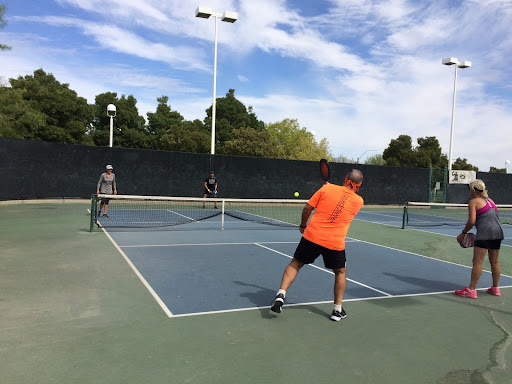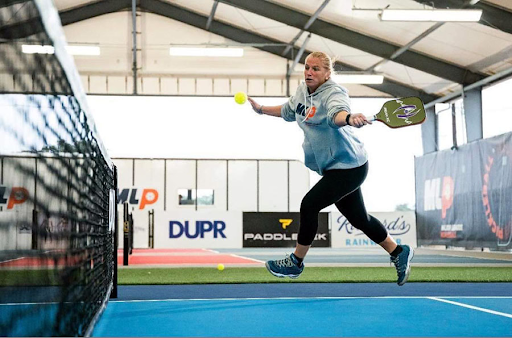I finally got the time to watch some of the matches from the USA Pickleball Newport Beach tournament that occurred late June/early July. The women’s doubles gold match was completed pretty efficiently, Todd and Bright made quick work against the Brascia sisters and it was over in two games.
Clearly, this was an important match for all four competitors; but I was keeping an eye on the players’ energy levels, especially because the game was heavily in favour of Todd and Bright.
I noticed a close line call could have easily swayed the attitude of Todd and Bright but it didn't happen. Likely because they had such a commanding lead at the time, but, I got thinking about the common scenarios that can generate on-court controversy...
Line Calls
Right, no shocker here. Close line calls can stir even the most harmless pot - or - game. I will say that the person standing closest to the ball should generally be making the call and less so their teammate.
If you are making a line call for your teammate because their head is up and not looking at the paddle making contact with the ball then you might be in a better position to make the call.
However, if you’re standing all the way on the other side of the court and you and your teammate have been pulled off the court by an angular shot, I’m really not sure you’re in the best position to be making that final call.
Using the image below, take a look at the players on the far side of the court. Let’s say the ball goes out near the sideline of the play in grey but her partner - who’s on the baseline - calls the ball out before she does.
As the team in orange and pink I’d be wondering how the heck that player on the baseline could see exactly where the ball bounces out of bounds. It’s been done before and whenever that’s happened to me, I will call the ball as I see it which can mean overturning my teammates initial call.
At the end of the day, it’s no hard feelings, it’s about playing the ball as you see it and being as fair as possible.

Photo credit: Sara McInnes
In the past, I’ve played against some teams who've made questionable line calls similar to the situation described above. The call was made by the person so far from the actual ball and when this happened, things just didn’t go so well.
Let’s just say, when that happened, my teammate got pretty heated and it took several minutes to resolve it. The game eventually played on but with a lot of additional tension.
Keep in mind, having a referee officiating the game might make for a faster resolution but it’s not always fair. The referee can only overturn a call if they’ve actually seen the ball well enough and have been asked to overturn the call by the opposing team.
Referees who make bad line calls are also a huge point of contention. Recently, there are a good number of pros voicing their opinion on referees overturning line calls that likey cannot see the inside of the line.
If I’m not mistaken, many pro matches including the medal rounds no longer have line referees, the players would prefer to make their own calls.
The only instance that really makes sense for the person who’s not closest to the ball making that line call is on a serve or return. Example below, the player in the white hat is the server and in this case, it’s often easier for the teammate to make the line call if the return sails long.
-1.jpg?upscale=true&width=900&upscale=true&name=unnamed%20(1)-1.jpg)
Photo credit: Sara McInnes
In the image below, the receiver in white is the obvious player to make the line call but actually, his teammate is not in a bad position either. If the serve is out, his teammate could actually see space (grey court) between the baseline and the ball, when the ball lands.
.jpg?upscale=true&width=1024&upscale=true&name=unnamed%20(2).jpg)
Photo credit: Sara McInnes
With regards to line calls, my recommendation is that unless it’s a critical point in the game or someone is very obviously judging the situation incorrectly, at a certain point they need to be called out, to let a bad call go. Strategically, I don’t want to waste energy or allow myself to be distracted by a bad line call and allow momentum to slip away from my team.
Ball Compression
Line calls and ball compression go hand-in-hand, because of the ongoing debate whether a pickleball ball compresses or not; and the current USAP ruling on line calls leaves the decision somewhat open to the players as they see the ball land. USAP Section 6:
6.B. Except the serve, any ball in play that lands in the court or touches any court line is in.
6.C. A ball contacting the playing surface completely outside of the court is “out”.
When a plastic pickleball lands on the ground, it has less compression than say, a rubber tennis ball landing on a court. When I first entered pickleball I was told that there is no compression with a plastic pickleball at all and that when the ball lands close to the outside of the sideline that the ball is in fact “out”.
Take a look at the image below: do you think the ball is touching the line? Above the white line is the out-of-bounds area and below the white line is the inside of the court.
.jpg?upscale=true&width=1024&upscale=true&name=unnamed%20(3).jpg)
Photo credit: Sara McInnes
Now take at this image, same ball just a different angle - but does your answer to the first photo now change? Again, above the white line is out of bounds and below is inside the court.
.jpg?upscale=true&width=1024&upscale=true&name=unnamed%20(4).jpg)
Photo credit: Sara McInnes
Because the tighter line calls can also be dependent on the angle of each player's perspective there is absolutely a grey area with regards to line calls, thus, making this one of the most controversial areas of the game.
Did the Ball Make Contact?
Did the ball make contact with your hair? When the ball is clearly on its way out of the court sometimes it will catch a piece of clothing, hair or even tip the paddle. Players will notice these small instances and even with eight eyes on the ball, you’d be surprised just how hard it can be to actually determine if contact was made.
The pros on tour are just starting to have access to video recall and at certain tournaments are granted two challenges per game, however, this is unrealistic for the rest of the world playing pickleball.
Therefore, I’m still sticking with the mentality that unless a questionable call is made in a very critical point of a match, it’s not worth the energy or distraction to follow up and to let a “wrong” call go.
The Whitwell Pathway
Pro player Lee Whitwell is notorious for ernes. As a leftie she sets herself up brilliantly for ernes on the right side of the court. However, the advantage to video replay is that plays are getting challenged and she’s now getting caught running through the non-volley zone as opposed to running around it or jumping over it (the main action of an erne shot).
Although “controversial”, it was made into a more light-hearted situation the moment someone coined the scenario “Whitwell Pathway”.
What remains at the root of this debate though and what frustrates some people in the community is that if Whitwell now knows she’s guilty of running through the non-volley zone but continues to do so, isn’t that like, almost cheating because it’s intentional?
I personally, don’t have an opinion to deliver to you, I’m a neutral party in this matter. What are your thoughts? If you’re curious about what an erne shot is or what the Whitwell Pathway looks like, I recall seeing plenty of video replays during the first season of Major League Pickleball (MLP), which is now on YouTube.

Photo credit: Port Townsend Pickleball Club
Legal vs Illegal Serves
Was the serve struck above the waist? Where’s the person's waist? Was the one handed flick covered up too much? Did the ball actually drop on that drop serve or was it pushed down?
How about: did the server strike the ball on their partners half of the court? Those are all examples I’ve heard more than once and that cause a match to pause in play. Off court the conversation about serving continues as well. Too many times people have asked “someone told me that my serve is illegal, what do you think?”.
Overall, being called out for serving illegally is a sensitive subject. When one is called out it seems to be taken pretty personally. On the other hand, an illegal serve is an illegal serve.
If someone’s serve is not falling within the parameters then isn’t it better to be called out? In the few times I’ve pointed out the reason why a serve is illegal, I’m intentional when I choose to speak up, lessons aside.
It can be awkward to call someone out during a competition but there is a reasonable approach, which I tend to take. Either, you let the official know to keep an extra eye on so-and-so’s serve either between points or between games; or when the match is not refereed, you let the person know by asking them to keep closer attention to their serve. If it continues, a fault must be called.
To simply call a fault the very first time you notice the illegal often causes a stronger reaction by the other team. At the end of the day, it’s your call as to when to speak up.
Fortunately, there’s a complete breakdown of the rules: section 4 of the 2022 USAP Official Rulebook. It’s worthwhile fully understanding the rules surrounding the two types of legal serves before heading to a competition and before playing with new groups.
This article was taken from our 'Control the Kitchen' Newsletter, if you're interested in receiving more content like this, please feel free to sign up using the subscribe section located at the bottom left of this page (or underneath the article if you're on mobile), thanks!